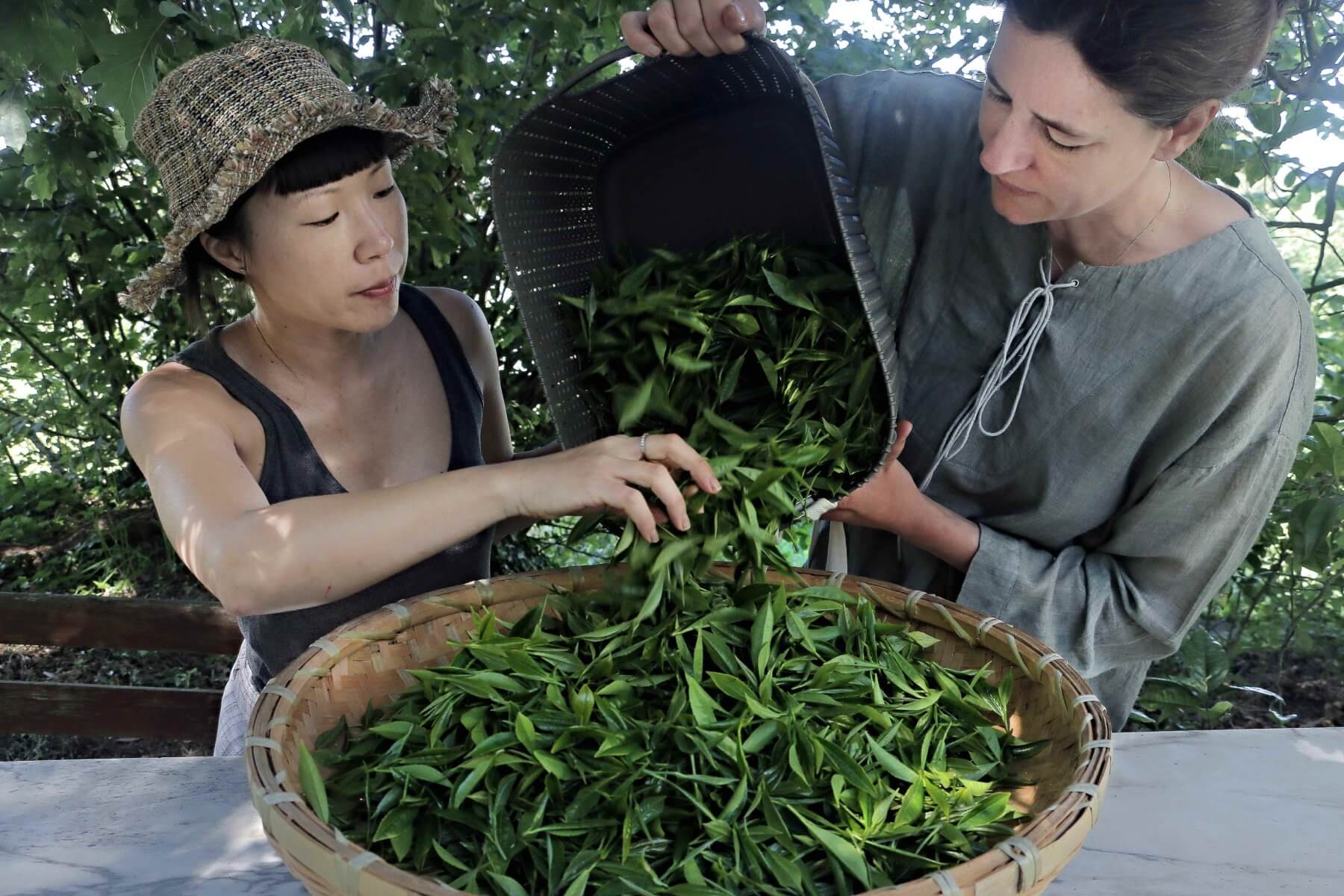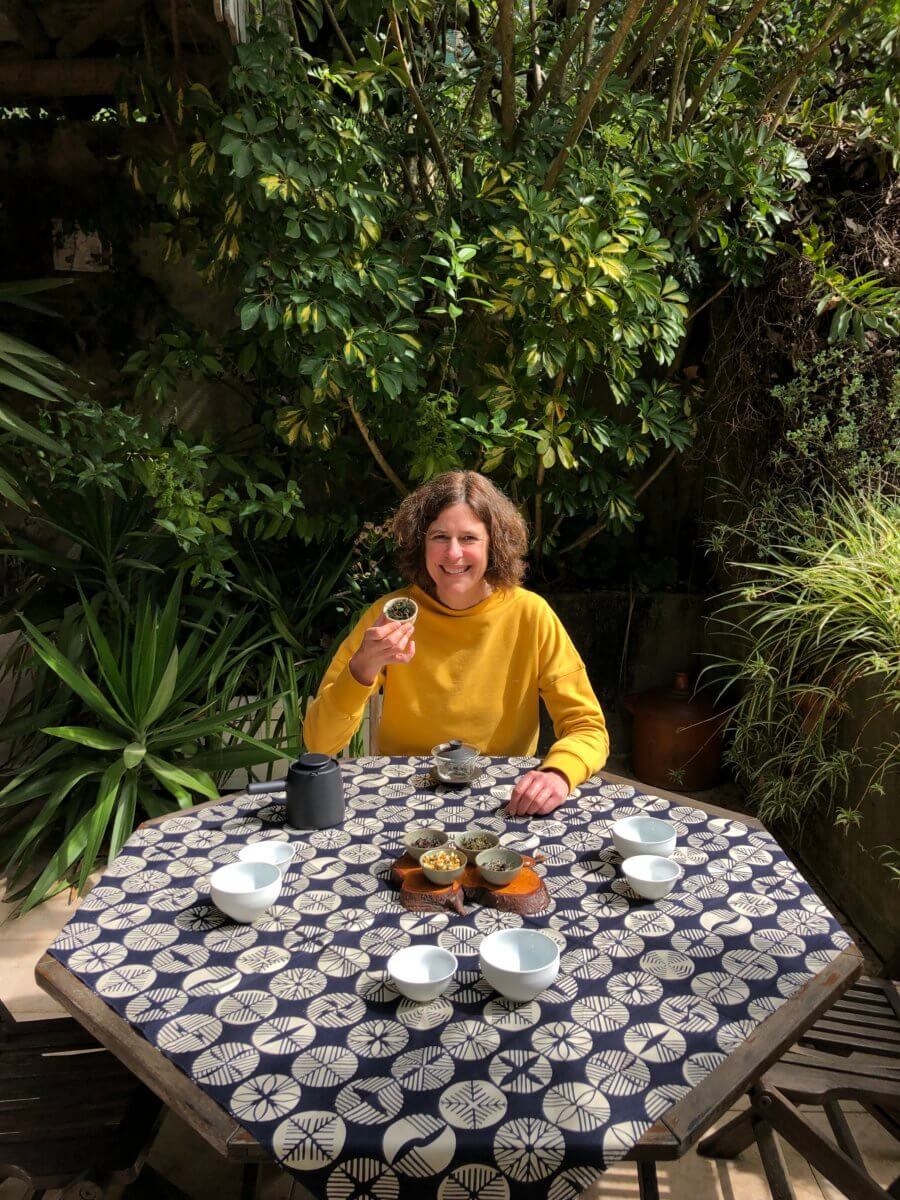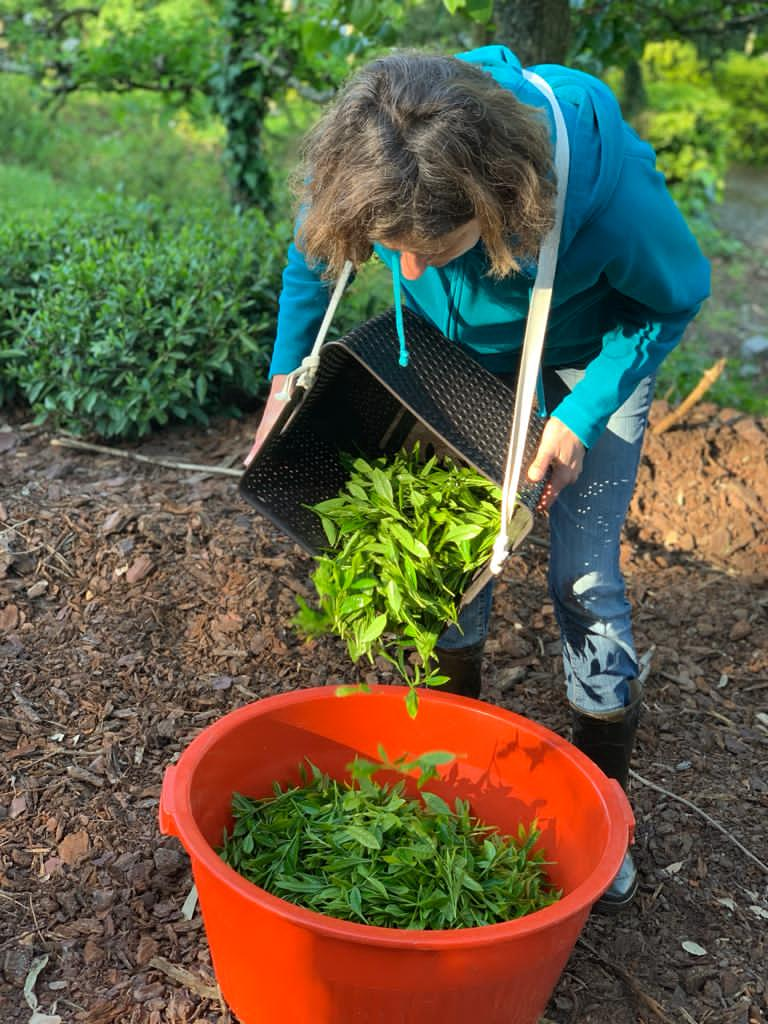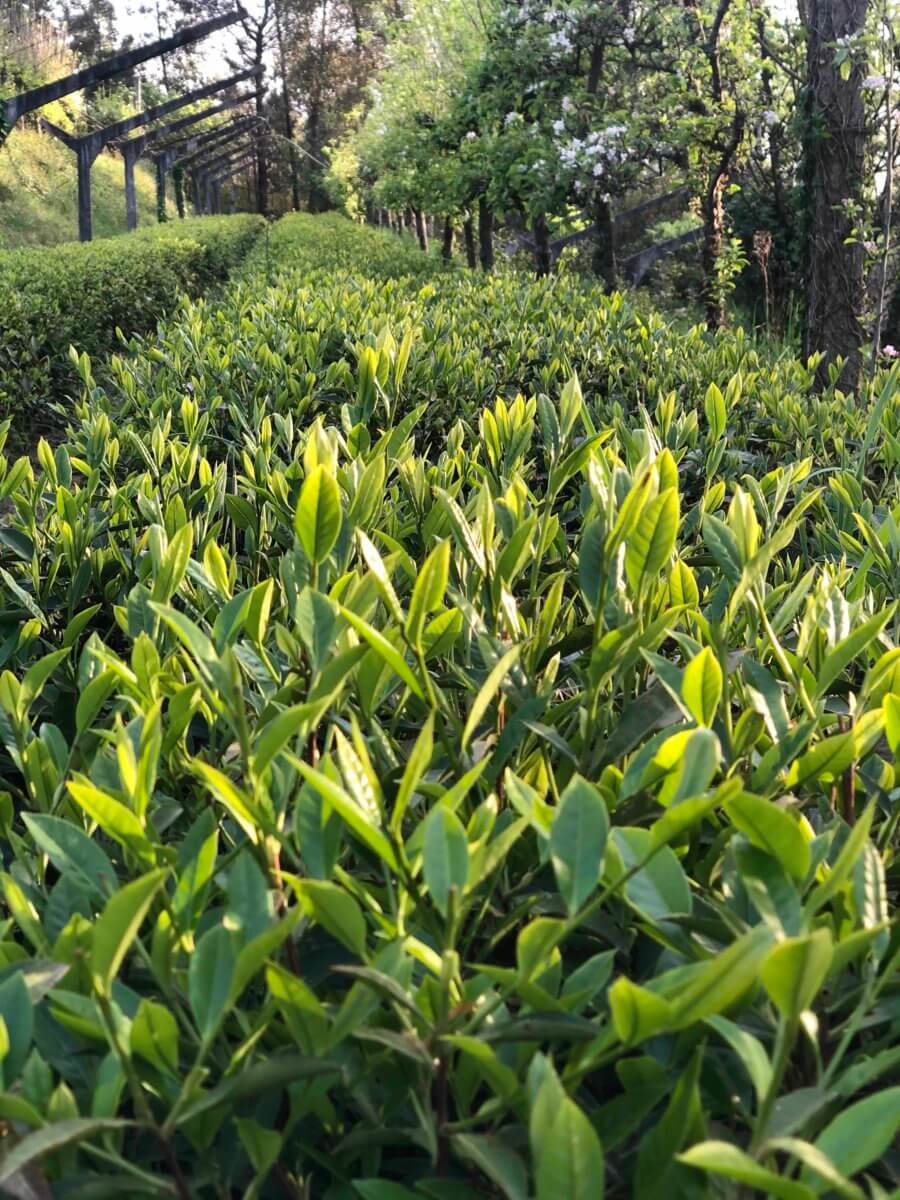A single word holds the key to the magic to so much of what we understand about the world of taste and flavour today – Umami. But what is this famous fifth taste, where do we find it, and why is it that we can’t get enough of it?
Green Tea & Umami: the Extraordinary Journey of Green Tea from Japan to Portugal, with Nina Gruntkowski and Chá Camélia
Umami is synonymous with Japan in many ways, in everything from their cuisine to their tea ceremonies, but there’s no reason the illusive ‘fifth taste’ can’t be produced in other countries too. This was exactly the thought that struck journalist Nina Gruntowski one day, when she discovered that green tea could be successfully grown in the Northern Portuguese climate, known as the “land of camellias”. Nina is now pioneering Portuguese tea growing with the Chá Camélia project, which she launched together with her partner, Dirk Niepoort, in 2012. She has a hectare of tea plants growing in Fornelo, Vila do Conde, which she grows according to biological and biodynamic principles.
Green tea, when grown and produced correctly, is rich in umami flavours. It contains a significant amount of glutamate and theanine, types of amino acid which imparts this pleasant, savoury taste. Inspired by the ancient tea cultures of Asia, and Japan in particular, Nina talks to us about how she’s working to produce artisanal, high quality tea in Europe.

Tell us about what sparked the idea to start growing tea in Portugal?
I was working as a journalist for the German radio, but I always had the dream to set something up on my own. I was already a passionate tea drinker and my husband is a wine producer who is also very keen on tea. Anyway, with someone called Peter Oppliger in Switzerland, who had the first little tea plantation that’s sort of like a museum. During the interview, he mentioned to me that there’s one kind of tea plant called Camellia sinensis. When I heard that name it was like an awakening, I almost derailed the interview because I suddenly had an idea: where I live in the North of Portugal is called the Land of the Camellia Trees, and I suddenly thought “why can’t we grow tea here?”. So I decided to do an experiment and plant a single tea plant in the coolest corner of the garden. My thinking was that if it survived there over winter in Portugal, I was in with a chance. I thought if it does well on its own, it’s meant to be, because nature has to decide.
Since the beginning we have been certified organic, because for me tea is really a holy plant and I can’t imagine wanting to cultivate it with fertilisers, chemical substances or pesticides or whatever.
So then we planted 200 tea plants in our garden. They were doing very well, and soon we got in contact with the Morimoto family of excellent tea producers from Japan. They agreed; our climate and soil is very similar to Japan, and they gave us great encouragement. And that was how Chá Camélia was born.
And then how did you go about setting up the company?
Our mission is not only to produce our own tea, but also to share our passion for and knowledge of the complex world of tea. Since 2012 we have distributed the organic teas of the Morimoto family and of other small family producers in Japan. After the successful trial with the tea plants in our garden, we decided to start planting tea at a little farm in Fornelo, North of Porto. In 5 years we created and planted 12,000 Camellia sinensis for planting almost 1 hectare.
After two years of small, experimental production in our garden, in 2019 we celebrated our first harvest of the sufficiently mature tea plants. It was a very special moment for everyone involved. Now every year we step up to the challenge of transforming larger quantities of fresh leaves into green tea—a magical and complex process. Our tea leaf harvest is entirely manual, and furthermore, so is the majority of the transformation process

Tell us about your growing principles – what does being organic and biodynamic mean in practice?
Since the beginning we have been certified organic, because for me tea is really a holy plant and I can’t imagine wanting to cultivate it with fertilisers, chemical substances or pesticides or whatever. So we are organic but we go much, much further, in many of the same practices as with wine. I learnt a lot about the formation of biodynamic wine practices through my husband’s wine business, but I’m going much further. I would call it natural farming: essentially, trying to create a cycle of organic material, to always feed the soil with biodynamic compost. So we make every year a pile of compost of cow manure and straw and leaves and leather, which we leave to decompose for a year before adding to the plants. It is much more than just the minerals – you have lots of worms and other microorganisms in it, and it’s like gold! It improves the whole life in the soil.
Our mission is not only to produce our own tea, but also to share our passion for and knowledge of the complex world of tea.
We treat our plants totally naturally and biodynamically. In spring we spray stinging nettle tea on the leaves on the plants, in summer camomile for getting them less stressed by heat, and in autumn horsetail for bettering the structure of the leaves. We don’t have any impact from machines on our soil. We do everything by hand. At first it’s a huge amount of work, taking out the weeds, pruning every plant, but after four or five years the plants grow over the weeds and you’ve won the battle.
In nature, the tea plant grows in the second layer of subtropical forests beneath the bigger trees, so it really likes the shade from a neighbourhood of trees. So on the farm we have lots of vegetation, we have lots of old trees which we’ve left. We have very high biodiversity, which also helps in natural farming so that you have a balanced ecosystem.

So you’ve mentioned biodynamic growing and vines which you grew here. Are there other similarities between growing vines and tea?
Yes. Tea plants are very comparable to vines, and can live for up to 200 years. If you leave them they grow like trees, living about 300 years. The biggest thing is that we are tasting, tasting, tasting, tasting. Wines, olive oil, salt bread, whatever it is, we were already very accustomed to tasting. I think if you’re a producer you should really have good taste and that in the end you know what kind of product you would like to produce. To be able to judge that is really helpful.
Besides that, tea is much quicker in production than wine. We pick the leaves in the morning and it’s ready to drink in the afternoon. But we have to blend the different batches of production of course, and there we have again a big similarity wine because many wines especially here in Portugal are blended. This is fascinating for me, coming from Germany where you have more monocast wines, just one variety, rather than the complex blends you get in Portugal.
We focus on green tea, which is very Japanese thinking, whereas in China for example most tea producers produce all colours of tea. I want to perfect our green tea, then we might move onto other palates.
And what is so special about green tea, in terms of its properties and chemical make-up, as well as its taste?
Green tea contains a significant amount of glutamate, a type of amino acid which imparts a pleasant, savoury umami taste. Anyone who has tried green tea will perhaps have sensed varying levels of sweet, umami, astringent, and bitter tastes, according to blend and variety. The sweet and umami tastes are said to result from the presence of theanine and glutamate, both types of amino acid, the astringent taste from catechin, and the bitter taste from caffeine. In green tea you have some of the same benefits like in red wine, you have the tannins, which are extremely interesting.
For me one of the most interesting things is the release of caffeine. Whereas in coffee it’s released quickly and then you have a dip, in green tea the curve of caffeine is much longer and smoother. Sometimes this still means you can’t drink, as it’s still having the effect much later, but you don’t have the effect on the cardiovascular system that coffee gives, it’s not so aggressive. And then finally, you have the sweetness from the amino acids.

What inspiration do you take from ancient Asian (and especially Japanese) tea traditions?
We are Little Japan here, as you can see! Even on the Quinta, on our farm, many things look very Japanese. I am deeply attracted to the Japanese aesthetic and way of doing things. I can’t change this and I won’t!
Our whole production is very much inspired by the Japanese way of tea production, but we are doing it much more manually, because we can’t buy all the machines and so on, so we do it much more manually than most tea farms in Japan.
I think if you’re a producer you should really have good taste and that in the end you know what kind of product you would like to produce. To be able to judge that is really helpful.
We focus on green tea, which is very Japanese thinking, whereas in China for example most tea producers produce all colours of tea. I want to perfect our green tea, then we might move onto other palates. Also in China green tea is produced in a very hot pan, while in Japan they are steamed, and we follow the steaming methods because we really like the flavour it produces. The rest of the production is also inspired by Japan, but it is much artisanal. This year for example, for the first time we are doing a shading experiment, with the original pergolas we used for vineyards. We want to make a comparison on how shading affects the umami of the leaves.
This issue is all about umami – what are we looking for in terms of flavour when we’re tasting umami in green tea? How would you describe the taste it gives to the tea?
You have a nice taste in the mouth when you have the liquid, but when you have swallowed it the taste grows in sweetness and volume and complexity, which develops after having drunk the liquid. It’s very easy to understand when you have a high umami tea. When you do tea tastings in Japan people are really tuned into picking out umami, whereas when we started here in Portugal ten years ago this was the first time they were able to properly identify umami as it wasn’t a known flavour. Actually green tea is a very easy way to pick it out, because it’s so clean and pure, so it’s a great example of what umami is.

What growing conditions are needed to cultivate good umami?
Green tea with high umami is usually shaded tea. Umami in general is found in the early spring teas, from regions where the plants have a cold winter, or where the plants are stagnating in growth. In Japan, just like in Portugal, growth stops from roughly December to February. This is when the plant rests, and there are lots of sugars and starch in the roots. Then the spring rain and the sun comes and awakens the plants to grow, and the first leaves have more amino acids so they’re more sweet. This is also the reason why the first spring teas usually are the most valuable, the most tasty if you’re someone who likes umami.
Often when I serve green tea people who think they don’t like it are amazed, because it can taste so good if it’s made right.
In Japan they developed a technique to cause the plant to even create more umami flavour in the young leaves, which is by shading the plants completely two to three weeks before the harvest. So the leaves grow slower, they are smaller, finer, greener and sweeter. They develop less bitterness. And this is very interesting because then you can push high umami flavours in teas like Gyokuru, which is the most valuable Japanese leaf tea. It’s the brother of matcha. So there you find very, very high sweetness due to the fact that the plants are shaded three weeks before harvest.
And what is the optimum level of umami?
It’s very personal, it depends on your tastes, but I think in Japan sometimes it’s too much. Really sweet, sweet, sweet, and you can push it also with fertilisers. So I guess I associate overly high umami with fertilisers, which I’m not a fan of. I personally like the Kabusechas, which are a bit less time shaded than Gyokuro. They are between Sencha and Gyokuro, and for me they have a better structure, more complexity.

And finally, there is a real art to brewing green tea that releases umami without becoming too bitter or astringent. Can you tell us a bit about this?
Yes, absolutely, this is probably the single most important thing when it comes to drinking green tea, and the thing we get wrong most here in Europe. So… it’s about the quality of the tea, of course, which makes a huge difference, and paying a bit of attention to the way it’s brewed.
The right way to prepare and enjoy tea would be to have a small 300ml teapot, and to brew it with water that’s no more than 70 degrees celsius, just 1.5 minutes of infusion, and doing several infusions. A big mistake is to make one infusion in a huge pot, like you would with coffee, and then leaving it to oxidise. The interesting part is that in the first infusion, you will have the most caffeine, which is the first substance which goes out in the hot water. And then as you make more throughout the day you have less and less caffeine, with almost none by the third infusion. This explains why in Asia people drink green tea all day long and don’t get hyper from the second infusion of the same leaves, and that’s also why they are willing to spend more money for good leaves, as they get much more out of it. I really want to show people that it can be more economical to buy a high quality tea and brew it several times and have more pleasure. Often when I serve green tea people who think they don’t like it are amazed, because it can taste so good if it’s made right.
